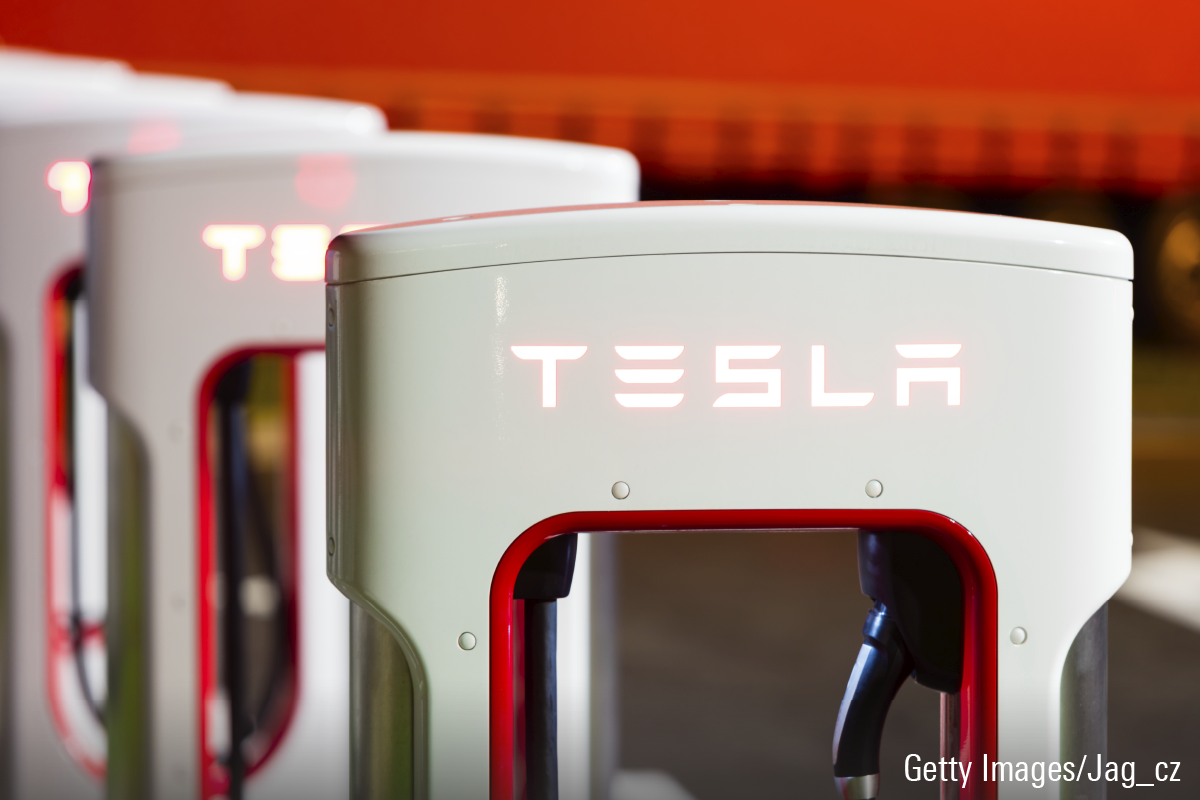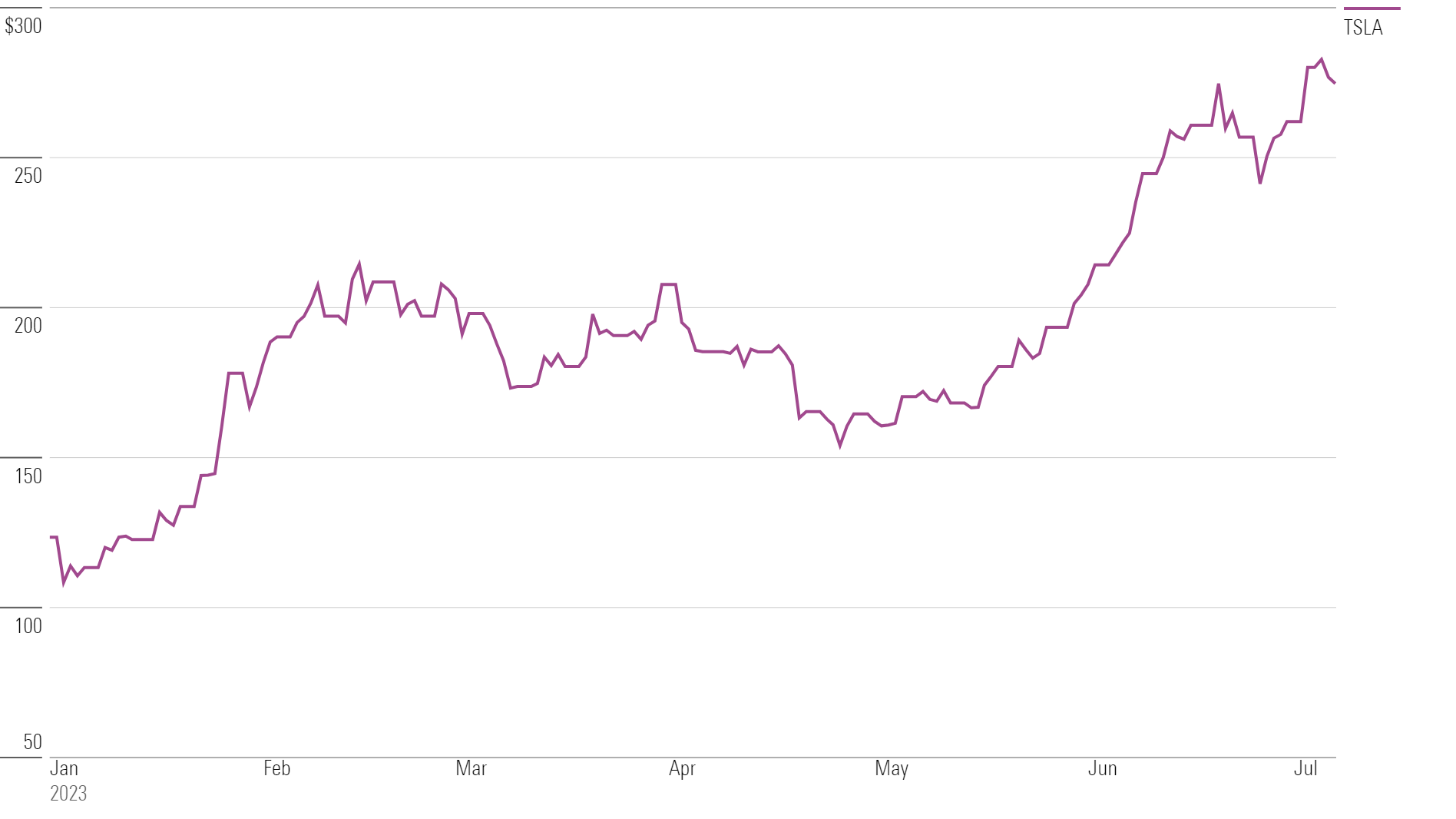Ahead of Earnings, Is Tesla Stock a Buy, Sell, or Fairly Valued?
After the company delivered a record-high number of vehicles during the second quarter, here’s what we think of Tesla stock.

Tesla TSLA is scheduled to release its second-quarter earnings report on July 19 after market close. Here’s Morningstar’s take on what to watch for in earnings.
Key Morningstar Metrics for Tesla
- Fair Value Estimate: $215
- Morningstar Rating: 2 stars
- Morningstar Economic Moat Rating: Narrow
- Morningstar Uncertainty Rating: Very High
What to Watch for in Tesla’s Earnings
- Companywide operating profit margin: In addition to automotive gross profit margin, this incorporates the profit margin for the energy generation and storage segment, as well as overhead expenses.
- New-vehicle timelines: Tesla has previously said the Cybertruck will be released later this year, so look for commentary on that, as well as the potential launch date for the new lower-priced vehicles.
- Raw materials costs: On the first-quarter call, management said costs of raw materials would begin to decline, so look for updates here.
- Price vs. profit strategy: Tesla has cut prices to boost volumes, but look for commentary on how the company views price cutting versus profits. On the last earnings call, CEO Elon Musk said (perhaps jokingly) Tesla could theoretically sell cars at zero profit and still be fine, meaning the company could cut prices a lot more.
- Update on full self-driving software: Management’s view is that customers paying for full self-driving software will be a long-term profit stream, making lower upfront profits on car sales less important. But this depends on the technology being widely released to all customers, so look for an update.
Tesla Stock Price

Fair Value Estimate for Tesla
With its 2-star rating, we believe Tesla stock is overvalued compared with our long-term fair value estimate.
Our fair value estimate for Tesla stock is $215 per share. In the near term, we forecast that Tesla will increase its annual total vehicle delivery volume to a little over 1.8 million in 2023, or roughly 37% versus 2022. However, because of price cuts far exceeding cost savings, we forecast automotive gross margin contraction in 2023 to 22% from the 29% achieved in 2022.
In the longer term, we assume Tesla will deliver around 5 million vehicles per year by 2030. This includes fleet sales—an expanding opportunity for the firm. We think Tesla will be successful in continuing to reduce its manufacturing costs on a per-vehicle basis. Additionally, we assume the company’s overhead expenses continue to decline as a percentage of sales as it benefits from operating leverage as deliveries increase.
Read more about Tesla’s fair value estimate.
Tesla Historical Price/Fair Value Ratios

Economic Moat Rating
We award Tesla a narrow moat rating, stemming from its intangible assets and cost advantage. The company’s strong brand cachet as a luxury automaker commands premium pricing, while its electric vehicle manufacturing expertise allows it to make its vehicles cheaper than competitors.
We think these moat sources will persist, allowing the firm to generate excess returns on capital. We see the potential for Tesla to out-earn its cost of capital over at least the next 20 years, which is the measurement we use for a wide moat rating. However, the second 10-year period carries significant uncertainty for both Tesla and the broader automotive industry, given the rapid advancement of autonomous vehicle technologies, which could transform how consumers use vehicles. As such, we view a narrow moat rating (which assumes a 10-year excess return duration) as more appropriate.
Read more about Tesla’s moat rating.
Risk and Uncertainty
We assign Tesla a Very High Morningstar Uncertainty Rating, as we see a wide range of potential outcomes for the company.
The automotive market is highly cyclical and subject to sharp demand declines based on economic conditions. As the EV market leader, Tesla is subject to growing competition from traditional automakers and new entrants. As new lower-priced EVs begin selling, Tesla may be forced to continue to cut prices, reducing the firm’s industry-leading profits. With more EV choices, consumers may view Tesla less favorably. The firm is investing heavily in capacity expansions that carry the risk of delays and cost overruns. The company is also investing in research and development in an attempt to maintain its technological advantage, with no guarantee these investments will bear fruit. Additionally, Tesla’s CEO owns a little over 20% of the company’s stock and uses it as collateral for personal loans, which raises the risk of a large sale to repay debt.
Read more about Tesla’s risk and uncertainty.
TSLA Bulls Say
- Tesla has the potential to disrupt the automotive and power generation industries with its technology for EVs, autonomous vehicles, batteries, and solar generation systems.
- Tesla will see higher profit margins as it reduces unit production costs over the next several years.
- Through the combination of Tesla’s industry-leading technology and its unique supercharger network, the company’s EVs offer the best function of any on the market, which should help the firm maintain its market-leader status as EV adoption increases.
TSLA Bears Say
- Traditional automakers and new entrants are investing heavily in EV development, which will result in Tesla seeing a deceleration in sales growth and being forced to cut prices due to increased competition, eroding profit margins.
- Tesla’s reliance on batteries made in China for its lower-price Model 3 vehicles will hurt sales, as these autos will not qualify for U.S. subsidies.
- Solar panel and battery prices will decline faster than Tesla can reduce costs, resulting in little to no profits for the energy generation and storage business.
This article was compiled by Lauren Solberg.
Get access to full Morningstar stock analyst reports, along with data and tools to manage your portfolio through Morningstar Investor. Learn more and start a seven-day free trial today.
The author or authors do not own shares in any securities mentioned in this article. Find out about Morningstar’s editorial policies.

/s3.amazonaws.com/arc-authors/morningstar/ca8d2ce1-cd0f-433b-a52b-d163be882398.jpg)
/cloudfront-us-east-1.images.arcpublishing.com/morningstar/4JOND5R2SBFPZE63XWPYQDG56A.png)
/cloudfront-us-east-1.images.arcpublishing.com/morningstar/K36BSDXY2RAXNMH6G5XT7YIXMU.png)
/cloudfront-us-east-1.images.arcpublishing.com/morningstar/BG4IFJHA25B6RKD3XNUYKROBBM.jpg)
:quality(80)/s3.amazonaws.com/arc-authors/morningstar/ca8d2ce1-cd0f-433b-a52b-d163be882398.jpg)